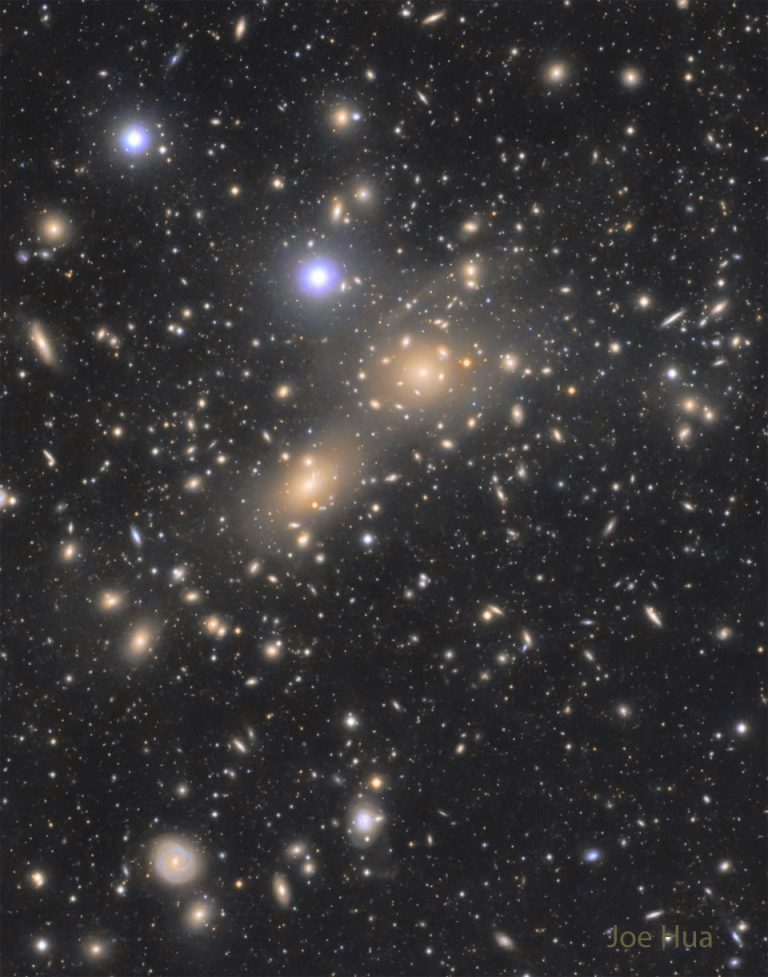疏散星团M35与NGC 2158
See Explanation. Clicking on the picture will download the highest resolution version available.
请参阅说明。单击图片将下载可用的最高分辨率版本。

See Explanation. Clicking on the picture will download the highest resolution version available.
请参阅说明。单击图片将下载可用的最高分辨率版本。

See Explanation. Clicking on the picture will download the highest resolution version available.
请参阅说明。单击图片将下载可用的最高分辨率版本。

一组天文学家研究了16个向太空发射强大光束的超大质量黑洞,以追踪这些射束或喷流现在指向的位置以及过去的目标位置。利用NASA的钱德拉X射线天文台和NSF NRAO的VLBA,他们发现一些射束的方向发生了较大改变。

请参阅说明。单击图片将下载可用的最高分辨率版本。

请参阅说明。单击图片将下载可用的最高分辨率版本。

一张满是模糊黄色斑点的图片呈现在眼前。所有黄色斑点都是星系,其中大多数是后发座星系团的成员。两个明亮的蓝点是我们银河系中的前景恒星。有关更多详细信息,请参阅说明。

2023年11月8日 Perseus Galaxy Cluster from Euclid Image Credit & License: ESA, Euclid, Euclid Consortium, NASA; Processing: Jean-Charles Cuillandre (CEA Paris-Saclay) & Giovanni Anselmi; Text: Jean-Charles Cuillandre Explanation: There’s a new space telescope in the sky: Euclid. Equipped with two large panoramic cameras, Euclid captures light from the visible to the near-infrared. It took five hours of observing for Euclid’s 1.2-meter diameter primary mirror to capture, through its sharp optics, the 1000+ galaxies in the Perseus cluster, which lies 250 million light years away. More than 100,000 galaxies are visible in the background, some as far away as 10 billion light years. The revolutionary nature of Euclid lies in the combination of its wide field of view (twice the area of the full moon), its high…

2023年11月2日 The Fornax Cluster of Galaxies Image Credit & Copyright: Marcelo Rivera Explanation: Named for the southern constellation toward which most of its galaxies can be found, the Fornax Cluster is one of the closest clusters of galaxies. About 62 million light-years away, it’s over 20 times more distant than our neighboring Andromeda Galaxy, but only about 10 percent farther along than the better known and more populated Virgo Galaxy Cluster. Seen across this three degree wide field-of-view, almost every yellowish splotch on the image is an elliptical galaxy in the Fornax cluster. Elliptical galaxies NGC 1399 and NGC 1404 are the dominant, bright cluster members toward the bottom center. A standout, large barred spiral galaxy, NGC 1365, is visible on the upper right as…

2023年9月12日 Galaxy Cluster Abell 370 and Beyond Image Credit: NASA, ESA, Jennifer Lotz and the HFF Team (STScI) Explanation: Some 4 billion light-years away, massive galaxy cluster Abell 370 is captured in this sharp Hubble Space Telescope snapshot. The cluster of galaxies only appears to be dominated by two giant elliptical galaxies and infested with faint arcs. In reality, the fainter, scattered bluish arcs, along with the dramatic dragon arc below and left of center, are images of galaxies that lie far beyond Abell 370. About twice as distant, their otherwise undetected light is magnified and distorted by the cluster’s enormous gravitational mass, overwhelmingly dominated by unseen dark matter. Providing a tantalizing glimpse of galaxies in the early universe, the effect is known as gravitational…

2023年7月15日 Webb’s First Deep Field Image Credit: NASA, ESA, CSA, STScI, NIRCam Explanation: This stunning infrared image was released one year ago as the James Webb Space Telescope began its exploration of the cosmos. The view of the early Universe toward the southern constellation Volans was achieved in 12.5 hours of exposure with Webb’s NIRCam instrument. Of course the stars with six spikes are well within our own Milky Way. Their diffraction pattern is characteristic of Webb’s 18 hexagonal mirror segments operating together as a single 6.5 meter diameter primary mirror. The thousands of galaxies flooding the field of view are members of the distant galaxy cluster SMACS0723-73, some 4.6 billion light-years away. Luminous arcs that seem to infest the deep field are even more…